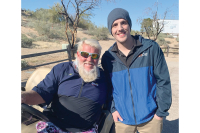Trying to put a square peg in a round hole? Kyle Ledford’s your man
 If there’s one thing Kyle Ledford is good at, it’s pushing boulders uphill.
If there’s one thing Kyle Ledford is good at, it’s pushing boulders uphill.
Call it grit, perseverance, stick-to-itness, Ledford has dedicated his life to solving the dropout conundrum, and he nearly has the code cracked.
The mastermind behind the Haywood Community Learning Center, Ledford’s model program has shepherded more than 550 would-be dropouts across the high school graduation stage since 2007.
The innovative program, funded largely through grants, gives non-traditional students the support and flexibility they need to earn a high school diploma and, more importantly, give them a shot at a better future as productive members of society.
Ledford’s biggest obstacle isn’t inspiring the students to continue their studies or building a support network to solve their social needs, however. It’s working within the confines of a rigid education system that doesn’t recognize his school as a school, nor recognize his students as students.
It’s a serious problem, since state education dollars are doled out based on student head count. Since these students are considered dropouts, even though they’re working their way toward a high school diploma they don’t pull down state dollars as traditional students do.
Related Items
“The state has never come up with a system to count these kids,” Ledford said. “So you find yourself between a rock and a hard place.”
Ledford has spent untold time and energy solving Catch 22’s surrounding his program. While figuring out how to get his students to actually count as students when it comes to the state funding formula is Ledford’s biggest hurdle these days, it wasn’t the most pressing challenge.
His first step back in 2007 was figuring out how to bestow the students with a high school diploma after completing their credits.
“A school is the only entity in this state that can grant a diploma,” Ledford said.
But the community learning center technically doesn’t count as a school. To do so, it would have to act like one — which would mean losing the very flexibility that makes it successful. The alternative learning center allows students to set their own schedules and progress at their own pace, and thus doesn’t meet the definition of a school in the state’s eyes. Instead, it’s considered a program under the umbrella of the school system, but not a school.
Ledford proposed a novel concept thanks to a cooperative partnership with the county’s original alternative high school, Central Haywood High.
Once Ledford’s students have earned the credits they need to graduate through his program, they are enrolled at Central Haywood High the same way a transfer student from another school district might be.
They never actually attend Central Haywood, but are enrolled just in time for graduation and is awarded a diploma bearing Central Haywood’s name, but based on the credits they earned through the Ledford’s program.
The system worked so ingeniously that students from the community learning center actually outnumber official Central Haywood graduates every year.
But there was another problem Ledford wasn’t willing to accept. Even though his students were going on to earn high school diplomas, they had already counted toward the county’s dropout rate.
“The efforts we were making were helping the kids, but it wasn’t doing anything for the school system’s drop ou rate,” Ledford said.
So Ledford set out to change the way the state calculates dropouts. It wasn’t easy, but he relentlessly made his case to Raleigh.
“We went to the state board of education and created a waiver, which we call ‘the box,’” Ledford said.
When students withdraw from their traditional high school, instead of being marked down as a dropout, they are now put in a holding place known as “the box.” If they ultimately graduate, they move out of “the box” and get counted as a graduate rather than a dropout for the purpose of statistics.
“When I get you, you go in the box and as long as you stay with me and do what you were supposed to do, you remain in the box until you graduate,” Ledford said. “The waiver took away the ticking clock.”
Thanks to Ledford’s pioneering system, the county’s dropout rate has dropped from 8 percent to less than 1 percent since 2007.
The waiver was so widely heralded as a perfect solution to an imperfect problem that it was adopted statewide last year under the banner of the Dropout Prevention Law, now serving as a model for other dropout programs around the state to use as well.
“The state really modeled their law after what we are doing. We were trying to solve a problem and that’s solving the problem,” Ledford said.
But there always seemed to be another problem around the corner for Ledford to tackle. The problem on his plate now is the how to get his students to count as students for the purpose of state per pupil funding.
It recently became an urgent priority when the Haywood County School System targeted the salaries of teachers at the community learning center in a sweeping $2.4 million budget reduction.
Ledford went into overdrive to find money that had been cut from other sources in order to try and save the program. He beat the bushes with his grant funders and looked under every rock. He was able to close the gap some, but is still short $61,000 needed to pay the teachers’ salaries.
So last week, Ledford made a trip to Raleigh to do what he does best: make a case for the innovative dropout recovery program he’s crafted.
“I didn’t come back with any money. I couldn’t do that. But I had a very lengthy, good long discussion with some legislators about what programs like mine do and what the need is,” Ledford said.
He has an invitation to return next month and testify before the entire legislature about the merits of the program.
“I was invited to speak about what the perfect dropout recovery program looks like,” Ledford said.
Ledford commended N.C. Sen. Jim Davis, R-Franklin, for helping pave his way with lawmakers in Raleigh.
“None of this could have happened if it wasn’t for him advocating on our part. He was very, very instrumental,” Ledford said.
There’s an option out there that would solve the problem of counting the students as students. They could simply remain on the books of the school they drop out of, but be released to his program for their studies.
They would continue to pull down the state dollars that the school system gets for each student on its roll, providing a critical funding stream that the program is now lacking.
“The problem is, if the kids were enrolled on the books of another school, the performance of the child goes for or against that school they are enrolled in,” Ledford said.
In other words, they would be subject to standardized tests that official students have to take, and their scores would count under the school they were on the books of.
“While that would fund us, that is not necessarily the fairest thing to do for the staff of the home school. Their accountability should be based on the students they are actually educating,” Ledford said. “We should be fully held accountable for our own performance, and our kids’ performance, whether good or bad, shouldn’t be counted against a school that has had nothing to do with their education of that student.”
Ledford has a few more tricks up his sleeve, and is currently honing what you might call a plan D, hoping to find a way around the state’s methodology of how it counts students for funding purposes. Some may call it gaming the system, but to Ledford, it’s being an advocate for kids that desperately deserve a second chance.
“Why have I not quit?” Ledford said. “Number one, I couldn’t leave my kids.”









